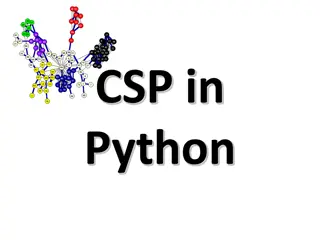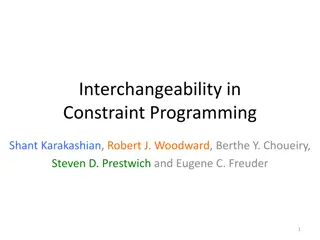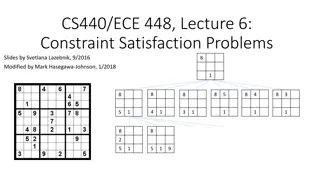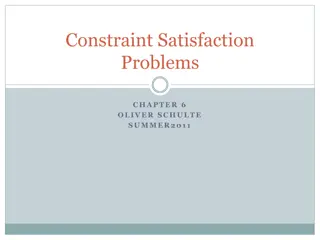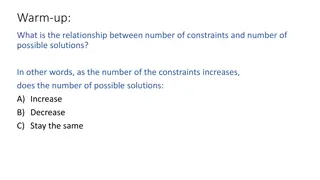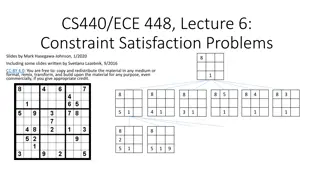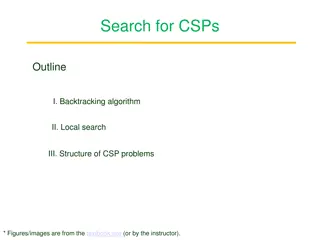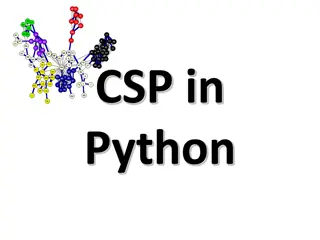Introduction to Constraint Satisfaction Problems
A Constraint Satisfaction Problem (CSP) involves assigning values to a set of variables while satisfying specific constraints. This problem-solving paradigm is utilized in constraint programming, logic programming, and CSP algorithms. Through methods like backtracking and constraint propagation, CSPs are efficiently solved. An illustrative example is the 8-Queens Problem, where the task is to place 8 queens on a chessboard so that none can attack another. CSPs require explicit constraint representations and manipulation algorithms for successful resolution.
Download Presentation

Please find below an Image/Link to download the presentation.
The content on the website is provided AS IS for your information and personal use only. It may not be sold, licensed, or shared on other websites without obtaining consent from the author. Download presentation by click this link. If you encounter any issues during the download, it is possible that the publisher has removed the file from their server.
E N D
Presentation Transcript
Constraint Satisfaction Russell & Norvig Ch. 6
Overview Constraint satisfaction is a powerful problem- solving paradigm Problem: set of variables to which we must assign values satisfying problem-specific constraints Constraint programming, constraint satisfaction problems (CSPs), constraint logic programming Algorithms for CSPs Backtracking (systematic search) Constraint propagation (k-consistency) Variable and value ordering heuristics Backjumping and dependency-directed backtracking
Motivating example: 8 Queens Place 8 queens on a chess board such That none is attacking another. Generate-and-test, with no redundancies only 88 combinations 8**8 is 16,777,216
Motivating example: 8-Queens After placing these two queens, it s trivial to mark the squares we can no longer use
What more do we need for 8 queens? Not just a successor function and goal test But also a means to propagate constraints imposed by one queen on others an early failure test Explicit representation of constraints and constraint manipulation algorithms
Informal definition of CSP CSP (Constraint Satisfaction Problem), given (1) finite set of variables (2) each with domain of possible values (often finite) (3) set of constraints limiting values variables can take Solution: assignment of a value to each variable such that all constraints are satisfied Possible tasks: decide if solution exists, find a solution, find all solutions, find best solution according to some metric (objective function)
Example: 8-Queens Problem What are the variables? What are the variables domains, i.e., sets of possible values What are the constraints between (pairs of) variables?
Example: 8-Queens Problem Eight variables Qi, i = 1..8 where Qi is the row number of queen in column i Domain for each variable {1,2, ,8} Constraints are of the forms: No queens on same row Qi = k Qj k for j = 1..8, j i No queens on same diagonal Qi=rowi, Qj=rowj |i-j| |rowi-rowj| for j = 1..8, j i
Example: Map coloring Color this map using three colors (red, green, blue) such that no two adjacent regions have the same color E D A B C
Map coloring Variables: A, B, C, D, E all of domain RGB Domains: RGB = {red, green, blue} Constraints: A B, A C, A E, A D, B C, C D, D E A solution: A=red, B=green, C=blue, D=green, E=blue E E => D A D A B B C C
Brute Force methods Finding a solution by a brute force search is easy Generate and test is a weak method Just generate potential combinations and test each Potentially very inefficient With n variables where each can have one of 3 values, there are 3n possible solutions to check There are ~190 countries in the world, which we can color using four colors 4190 is a big number! solve(A,B,C,D,E) :- color(A), color(B), color(C), color(D), color(E), not(A=B), not(A=B), not(B=C), not(A=C), not(C=D), not(A=E), not(C=D). generate test color(red). color(green). color(blue). 4**190 is 2462625387274654950767440006258975862817483704404090416746768337765357610718575663213391640930307227550414249394176L
Example: SATisfiability Given a set of logic propositions containing variables, find an assignment of the variables to {false, true} that satisfies them For example, the two clauses: (A B C) ( A D) equivalent to (C A) (B D A) are satisfied by A = false, B = true, C = false, D = false Satisfiability known to be NP-complete worst case, solving CSP problems requires exponential time
Real-world problems CSPs are a good match for many practical problems that arise in the real world Scheduling Temporal reasoning Building design Planning Optimization/satisfaction Vision Graph layout Network management Natural language processing Molecular biology / genomics VLSI design
Running example: coloring Australia NT Q WA NSW SA V T Seven variables: {WA, NT, SA, Q, NSW, V, T} Each variable has same domain: {red, green, blue} No two adjacent variables can have same value: WA NT, WA SA, NT SA, NT Q, SA Q, SA NSW, SA V,Q NSW, NSW V
Unary & binary constraints most common Binary constraints T1 NT Q T2 T4 WA NSW SA T3 V T Two variables are adjacent or neighbors if connected by an edge or an arc Possible to rewrite problems with higher-order constraints as ones with just binary constraints
Formal definition of a CN Instantiations An instantiation of a subset of variables S is an assignment of a value (in its domain) to each variable in S An instantiation is legal iff it violates no constraints A solution is a legal instantiation of all variables in the network
Typical tasks for CSP Possible solution related tasks: Does a solution exist? Find one solution Find all solutions Given a metric on solutions, find best one Given a partial instantiation, do any of above Transform the constraint network into an equivalent one that s easier to solve
Binary CSP A binary CSP is a CSP where all constraints are binary or unary Any non-binary CSP can be converted into a binary CSP by introducing additional variables A binary CSP can be represented as a constraint graph, with a node for each variable and an arc between two nodes iff there s a constraint involving them Unary constraints appear as self-referential arcs
Running example: coloring Australia NT Q WA NSW SA V T Seven variables: {WA, NT, SA, Q, NSW, V, T} Each variable has same domain: {red, green, blue} No two adjacent variables can have same value: WA NT, WA SA, NT SA, NT Q, SA Q, SA NSW, SA V,Q NSW, NSW V
A running example: coloring Australia NT Q WA NSW SA V T Solutions: complete & consistent assignments Here is one of several solutions For generality, constraints can be expressed as relations, e.g., describe WA NT as {(red,green), (red,blue), (green,red), (green,blue), (blue,red),(blue,green)}
CSP-backtracking(PartialAssignment a) If a is complete then return a X select an unassigned variable D select an ordering for the domain of X For each value v in D do If v consistent with a then Add (X=v) to a result CSP-BACKTRACKING(a) If result failure then return result Remove (X= v) from a Return failure Start with CSP-BACKTRACKING({}) Note: depth first search; can solve n-queens problems for n ~ 25 Basic backtracking algorithm
Problems with Backtracking Thrashing: keep repeating the same failed variable assignments Things that can help avoid this: Consistency checking Intelligent backtracking schemes Inefficiency: can explore areas of the search space that aren t likely to succeed Variable ordering can help
Improving backtracking efficiency Here are some standard techniques to improve the efficiency of backtracking Can we detect inevitable failure early? Which variable should be assigned next? In what order should its values be tried?
Forward Checking After variable X is assigned to value v, examine each unassigned variable Y connected to X by a constraint and delete values from Y s domain inconsistent with v Using forward checking and backward checking roughly doubles the size of N-queens problems that can be practically solved
Forward checking Keep track of remaining legal values for unassigned variables Terminate search when any variable has no legal values
Forward checking SA (South Australia) domain is empty!
Constraint propagation Forward checking propagates info. from assigned to unassigned variables, but doesn't provide early detection for all failures NT and SA cannot both be blue! Can we detect problem earlier?
Definition: Arc consistency A constraint C_xy is arc consistent w.r.t. x if for each value v of x there is an allowed value of y Similarly define C_xy as arc consistent w.r.t. y Binary CSP is arc consistent iff every constraint C_xy is arc consistent w.r.t. x as well as y When a CSP is not arc consistent, we can make it arc consistent by using the AC3 algorithm Also called enforcing arc consistency
Arc Consistency Example 1 Domains D_x = {1, 2, 3} D_y = {3, 4, 5, 6} Constraint Note: for finite domains, we can represent a constraint as an set of legal value pairs C_xy = {(1,3), (1,5), (3,3), (3,6)} C_xy isn t arc consistent w.r.t. x or y. By enforcing arc consistency, we get reduced domains D'_x = {1, 3} D'_y={3, 5, 6} y x C_xy
Arc Consistency Example 2 Domains D_x = {1, 2, 3} D_y = {1, 2, 3} Constraint C_xy = lambda v1,v2: v1 < v2 C_xy not arc consistent w.r.t. x or y; enforcing arc consistency, we get reduced domains: D'_x = {1, 2} D _y = {2, 3} y x C_xy
Aside: Python lambda expressions Previous slide expressed constraint between two variables as an anonymous Python function of two arguments lambda v1,v2: v1 < v2 >>> f = lambda v1,v2: v1 < v2 >>> f <function <lambda> at 0x10fcf21e0> >>> f(100,200) True >>> f(200,100) False Python uses lambda after Alonzo Church s lambda calculus from the 1930s
Arc consistency Simplest form of propagation makes each arc consistent X Y is consistent iff for every value xi of X there is some allowed value yj in Y
Arc consistency Simplest form of propagation makes each arc consistent X Y is consistent iff for every value xi of X there is some allowed value yj in Y
Arc consistency Arc consistency detects failure earlier than simple forward checking WA=red and Q=green is quickly recognized as a deadend, i.e. an impossible partial instantiation The arc consistency algorithm can be run as a preprocessor or after each assignment
General CP for Binary Constraints Algorithm AC3 contradiction false Q stack of all variables while Q is not empty and not contradiction do X UNSTACK(Q) For every variable Y adjacent to X do If REMOVE-ARC-INCONSISTENCIES(X,Y) If domain(Y) is non-empty then STACK(Y,Q) else return false
Complexity of AC3 e = number of constraints (edges) d = number of values per variable Each variable is inserted in queue up to d times REMOVE-ARC-INCONSISTENCY takes O(d2) time CP takes O(ed3) time
Improving backtracking efficiency Some standard techniques to improve the efficiency of backtracking Can we detect inevitable failure early? Which variable should be assigned next? In what order should its values be tried? Combining constraint propagation with these heuristics makes 1000-queen puzzles feasible
Most constrained variable Most constrained variable: choose the variable with the fewest legal values a.k.a. minimum remaining values (MRV) heuristic After assigning value to WA, both NT and SA have only two values in their domains choose one of them rather than Q, NSW, V or T
Most constraining variable Tie-breaker among most constrained variables Choose variable involved in largest # of constraints on remaining variables After assigning SA to be blue, WA, NT, Q, NSW and V all have just two values left. WA and V have only one constraint on remaining variables and T none, so choose one of NT, Q & NSW
NT Q WA Most constraining variable NSW SA V T Tie-breaker among most constrained variables Choose variable involved in largest # of constraints on remaining variables After assigning SA to be blue, WA, NT, Q, NSW and V all have just two values left. WA and V have only one constraint on remaining variables and T none, so choose one of NT, Q & NSW
Least constraining value Given a variable, choose least constraining value: the one that rules out the fewest values in the remaining variables Combining these heuristics makes 1000 queens feasible What s an intuitive explanation for this?
Is AC3 Alone Sufficient? Consider the four queens problem X1 X2 {1,2,3,4} {1,2,3,4} 1 2 3 4 1 2 3 4 X3 X4 {1,2,3,4} {1,2,3,4}
Solving a CSP still requires search Search: can find good solutions, but must examine non-solutions along the way Constraint Propagation: can rule out non-solutions, but this is not the same as finding solutions Interweave constraint propagation & search: perform constraint propagation at each search step
1 2 3 4 1 2 3 4 1 2 3 4 1 2 3 4 1 2 3 4 1 1 1 2 2 2 3 3 3 4 4 4





